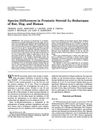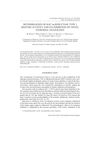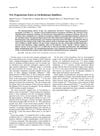TLDR Finasteride effectively blocks enzyme causing male pattern baldness.
This scientific paper from 1996 explores the mechanism by which finasteride inhibits human steroid 5α-reductase, an enzyme involved in the production of dihydrotestosterone (DHT), which is linked to male pattern baldness. The study found that finasteride acts as a potent bisubstrate analog inhibitor, forming a noncovalent complex with the enzyme that is irreversible and has a dissociation constant of K₁* ≤ 3 × 10-13 M. The study provides important insights into the mechanism of action of finasteride, which is commonly used to treat male pattern baldness and benign prostatic hyperplasia.
 211 citations
,
November 1990 in “The Journal of Steroid Biochemistry and Molecular Biology”
211 citations
,
November 1990 in “The Journal of Steroid Biochemistry and Molecular Biology” Finasteride effectively treats BPH, but needs more trials to understand potential.
 147 citations
,
April 1990 in “The Journal of Clinical Endocrinology and Metabolism”
147 citations
,
April 1990 in “The Journal of Clinical Endocrinology and Metabolism” Finasteride safely lowers DHT levels without affecting testosterone.
 193 citations
,
August 1985 in “Endocrinology”
193 citations
,
August 1985 in “Endocrinology” Different animals have unique versions of the enzyme that changes testosterone into another hormone, which is important for creating effective treatments for prostate and hair loss conditions.
 18 citations
,
October 2010 in “Bioorganic & Medicinal Chemistry Letters”
18 citations
,
October 2010 in “Bioorganic & Medicinal Chemistry Letters” New hybrid compound found to effectively prevent hair loss.
 4 citations
,
August 2010 in “Acta Biologica Hungarica”
4 citations
,
August 2010 in “Acta Biologica Hungarica” New steroidal compounds moderately block an enzyme related to testosterone conversion, less effectively than finasteride.
January 2005 in “Fuzhou daxue xuebao. Ziran kexue ban” The method is quick and effective for testing steroid 5 alpha-reductase inhibitors.
January 2004 in “Pharmaceutical biotechnology” Finasteride effectively inhibits the enzyme steroid 5 alpha-reductase II.
 22 citations
,
January 2001 in “Chemical & Pharmaceutical Bulletin”
22 citations
,
January 2001 in “Chemical & Pharmaceutical Bulletin” Some new progesterone derivatives are better at blocking testosterone conversion than a common drug.
 136 citations
,
March 1996 in “Journal of the American Chemical Society”
136 citations
,
March 1996 in “Journal of the American Chemical Society” Finasteride effectively blocks enzyme causing male pattern baldness.








